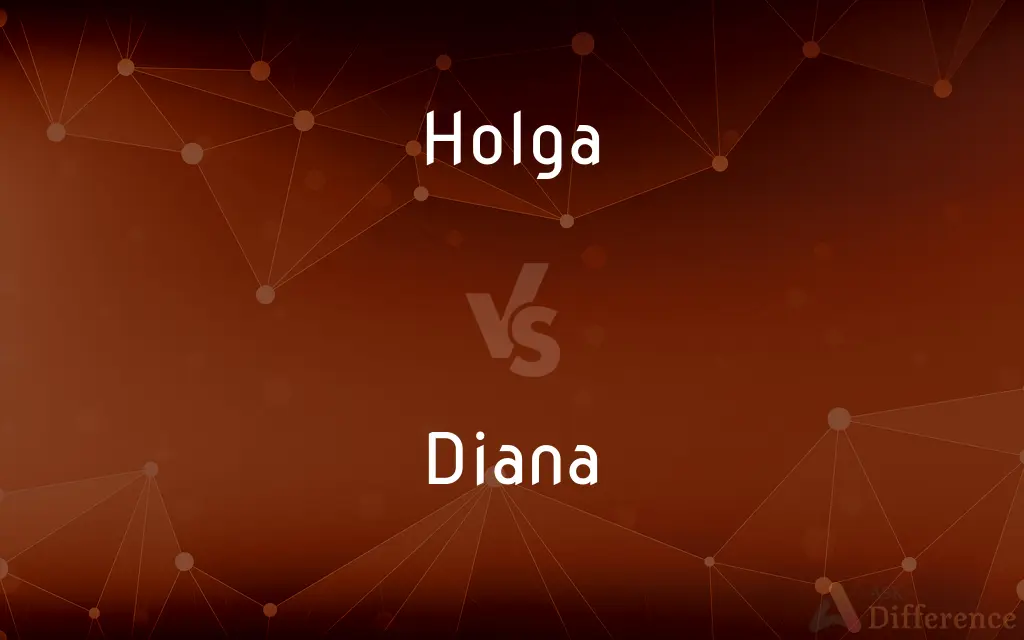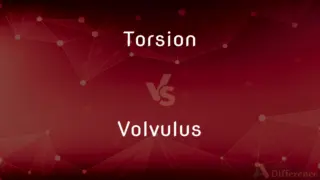Holga vs. Diana — What's the Difference?
By Fiza Rafique & Maham Liaqat — Updated on March 20, 2024
Holga and Diana are both types of toy cameras known for their low-fidelity, dreamy, and sometimes unpredictable photographic results, but they differ in origin, design, and cult following.

Difference Between Holga and Diana
Table of Contents
ADVERTISEMENT
Key Differences
Holga cameras, originating in Hong Kong in the early 1980s, were initially intended as an inexpensive mass-market camera for everyday use. They are characterized by their plastic lens, simple construction, and medium format film, typically 120 film. The images produced by Holga often exhibit soft focus, light leaks, and vignetting, contributing to its unique aesthetic appeal among enthusiasts of lo-fi photography.
Diana cameras, on the other hand, date back to the 1960s and were originally produced in Hong Kong as well. They are also made almost entirely of plastic, including the lens, and are known for similar lo-fi photographic qualities as the Holga, such as soft focus, vignetting, and unpredictable light leaks. However, Diana cameras traditionally used 120 film as well, but they are smaller and lighter than Holgas, and some models can use 35mm film with an adapter.
While both cameras are celebrated for their imperfections and the distinct, artistic quality of the images they produce, Holga cameras are often noted for their slightly more durable construction and versatility, with some models offering features like built-in flash or glass lenses. Diana cameras, however, are prized for their iconic retro design and slightly smaller form factor, making them a popular choice for photographers looking to capture a vintage aesthetic.
The communities of photographers that appreciate Holga and Diana cameras are drawn to the unpredictability and the experimental nature of using these cameras. Both have a cult following that values the serendipitous errors and the challenge of working with such basic equipment as part of the creative process in photography.
Despite their similarities, choosing between a Holga and a Diana often comes down to personal preference regarding design, handling, and the specific quirks each camera type offers. Both continue to play a significant role in the world of experimental and artistic photography, championing the charm of analog imperfections in a digital age.
ADVERTISEMENT
Comparison Chart
Origin
Hong Kong, early 1980s
Hong Kong, 1960s
Construction
Plastic body and lens, simple design
Primarily plastic, iconic retro design
Film Type
Primarily 120 medium format film
120 film, with some models adaptable to 35mm
Key Features
Soft focus, light leaks, vignetting
Soft focus, vignetting, lighter and smaller than Holga
Notable Differences
More durable, some models with built-in flash or glass lenses
Iconic design, more compact, some versatility with film type
Appeal
Unpredictable results, low-fidelity images with artistic quality
Vintage aesthetic, lightweight, and compact for artistic photography
Cult Following
Enthusiasts of lo-fi and experimental photography
Fans of retro aesthetics and experimental photography
Usage
Artistic, experimental photography with a preference for medium format
Artistic photography with a preference for a vintage look and compact size
Compare with Definitions
Holga
Known for its unpredictable photographic results, including light leaks and vignetting.
His Holga photos from the trip had unexpected light leaks that added a unique charm.
Diana
Produces photos with soft focus and vignetting, reminiscent of 1960s photography.
The Diana photos had a soft, ethereal quality that captured the nostalgic theme of the series.
Holga
An inexpensive, medium format film camera with a plastic lens.
The photographer captured the city's streets with the distinctive soft-focus effect of her Holga.
Diana
Enjoys a cult following among photographers who appreciate its vintage charm and imperfections.
The Diana camera workshop attracted enthusiasts eager to explore its artistic potential.
Holga
Appreciated for its simplicity and the creative challenge it presents.
She enjoys the challenge of composing shots with her Holga's limited settings.
Diana
A vintage-style, plastic-lens camera known for dreamy, lo-fi images.
His Diana camera, with its retro design, was a conversation starter at the photography club.
Holga
Often used in experimental and artistic photography for its distinctive aesthetic.
The art exhibit featured striking Holga photographs that emphasized texture and mood.
Diana
Compact and lightweight, making it popular for artistic and casual use.
She carried her Diana everywhere, loving its lightweight design for spontaneous shots.
Holga
Has a dedicated community of enthusiasts who value its quirks.
The online forum for Holga fans is a great place to share tips and photos.
Diana
Offers some flexibility with film types, especially models that can adapt to 35mm film.
He used a 35mm adapter with his Diana to capture vibrant street scenes.
Holga
The Holga is a medium format 120 film camera, made in Hong Kong, known for its low-fidelity aesthetic. The Holga's low-cost construction and simple meniscus lens often yields pictures that display vignetting, blur, light leaks, and other distortions.
Diana
The virgin goddess of hunting and childbirth, associated with the moon and identified with the Greek Artemis.
Diana
The daughter of Jupiter and Latona; a virgin goddess who presided over hunting, chastity, and marriage; - identified with the Greek goddess Artemis.
And chaste Diana haunts the forest shade.
Diana
(Roman mythology) virgin goddess of the hunt and the moon; counterpart of Greek Artemis
Common Curiosities
What kind of photographs can you expect from a Diana or Holga camera?
Expect images with soft focus, light leaks, vignetting, and a certain unpredictability, which many users find to be part of their charm.
Can you interchange lenses on Holga and Diana cameras?
Generally, the lenses on Holga and Diana cameras are fixed and not interchangeable, contributing to their characteristic photographic effects.
What is a Holga camera?
A Holga is a low-fidelity, medium format film camera, known for its plastic construction and unpredictable photographic results.
Why are Holga and Diana cameras popular in artistic photography?
They are popular for their unique ability to produce dreamy, imperfect images that many find artistically appealing, emphasizing mood and texture over technical precision.
Can Holga and Diana cameras use digital film?
Traditionally, they are designed for analog film, though some digital adaptations and modifications exist for enthusiasts.
How does a Diana camera differ from a Holga?
Diana cameras are similar to Holgas in their lo-fi aesthetic but are generally smaller, lighter, and often have a more retro design, with some models adaptable to 35mm film.
What are the challenges of using these toy cameras?
Challenges include limited exposure control, focus unpredictability, and the need for film development, but these are also seen as part of their creative appeal.
Why would someone choose to use a Holga or Diana in the digital age?
Many appreciate the tactile experience, the anticipation of film development, and the unique aesthetic that digital photography can't replicate.
How do you choose between a Holga and a Diana?
The choice often comes down to personal preference regarding size, design, film type, and the specific photographic quirks each camera presents.
Are Holga and Diana cameras suitable for professional photography?
While not professional in the traditional sense due to their unpredictability and technical limitations, they are used by professionals in artistic and experimental contexts.
Can you modify a Holga or Diana camera?
Yes, many enthusiasts modify their cameras to control light leaks, adapt to different film types, or alter the lens for different effects.
Share Your Discovery

Previous Comparison
Thereby vs. Whereby
Next Comparison
Torsion vs. VolvulusAuthor Spotlight
Written by
Fiza RafiqueFiza Rafique is a skilled content writer at AskDifference.com, where she meticulously refines and enhances written pieces. Drawing from her vast editorial expertise, Fiza ensures clarity, accuracy, and precision in every article. Passionate about language, she continually seeks to elevate the quality of content for readers worldwide.
Co-written by
Maham Liaqat














































